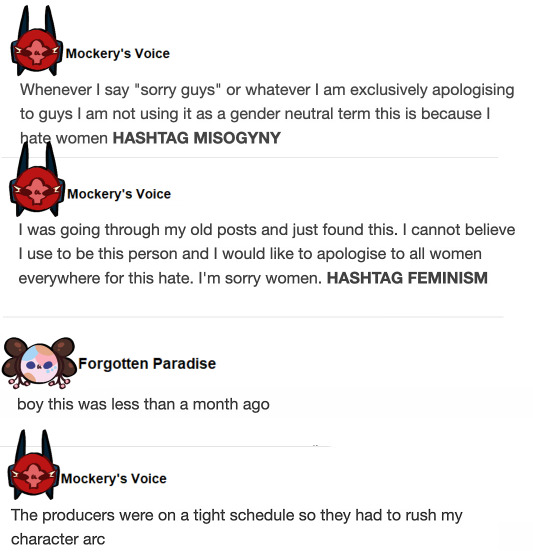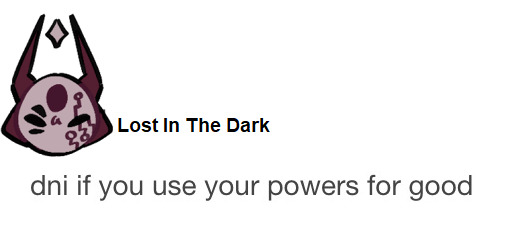#nlp
Text

Silly pirates au


#I'm gonna need another season of the gay pirates show#darkwing duck#darkwing doubloon#drake mallard#negaduck#jim starling#negawing#nlp#dwd#nega launchpad#negapad#liquidator#bushroot#quackerjack
303 notes
·
View notes
Text


Damien in 2024 can you believe it?
Also Magentus dealing with NLP and Negaducks divorce arc.

#my art#digital art#darkwing duck#art#ducktales#oc#ducksona#dwd oc#dwd#magentus#NLP#nega launchpad#Negaduck#Meme#meme art#goofy movie#i think we're gonna have to kill this guy#steven Universe
94 notes
·
View notes
Text
How ChatGPT Is Trained (Source: OpenAI)

#chatgpt#openai#coding#programming#programmer#developer#artificial intelligence#machine learning#data science#deep learning#computer science#nlp#ai#algorithms#tech#technology
221 notes
·
View notes
Text
Academic Papers on NLP
From one of my reddit comments...
So the best introduction to NLP is this video by Irving Kirsch. Here are the slides.
But if you want to really research NLP, you should get into the original papers. This is great fun and relatively easy these days. If you have Zotero and the Scihub plugin for Zotero, you can plug in any DOI link and it'll come up. You may have additional papers that you want to pull from citations; I use Semantic Scholar to turn citations into DOI links that I can get Zotero to pull.
So here's my research on NLP (if you copy and paste the URLs into https://sci-hub.hkvisa.net/ they'll give you the PDFs):
Predicate Matching in NLP
The Eyes Don’t Have It: Lie Detection and Neuro-Linguistic Programming
Research findings on neurolinguistic programming: Nonsupportive data or an untestable theory?
Mental imagery as revealed by eye movements and spoken predicates: A test of neurolinguistic programming
Neuro-linguistic programming treatment for anxiety: Magic or myth?
Double hypnotic induction: An initial empirical test
Neurolinguistic programming: a systematic review of the effects on health outcomes
There's also the papers that Michael Heap did:
Neurolinguistic Programming - An Interim Verdict
Neurolinguistic Programming: What is the Evidence?
Neurolinguistic Programming: A British Perspective
The Validity of Some Early Claims of Neurolinguistic Programming
Also recommended is @ellaenchanting's overview and Wordweaver's discussion on what NLP repackaged.
23 notes
·
View notes
Text

Not "user-friendly".
Wish it came with a manual or something.
#adhd#adhd brain#adhd problems#adhd women#nlp#nlp techniques#learning tips#train your brain#brain health#mental health#brainpower#self love#digital art#illustration#women artist
35 notes
·
View notes
Text
ChatGPT Invention 😀😀

ChatGPT is not new, Courage the Cowardly Dog was the first who use ChatGPT 😀😀😀😀
#chatgpt#chatbots#ai technology#openai#machine learning#nlp#ai generated#ai chatbot#artificial intelligence#stock market#conversational ai#ai#ai art#ai image#ai artwork#technology#discord
21 notes
·
View notes
Text
Hypnokink Basics: Special Techniques (pt 3)

Special Techniques
Introduction
This final section focuses not on inductions, but on the other stuff that hypnotists do or use as part of their hypnokinky scenes to make them go. Like the prior two sections this list is by no means inclusive, but just covers four of the more common and popular "adjunct" or "secondary" techniques that are often seen alongside hypnosis itself in the hypnokink community. That's not to say they are less important or less effective - many will tell you that these can be even more profound than traditional hypnosis itself, when properly and assiduously applied - but they do push the boundaries of what is hypnosis in some cases, or in others are simply techniques that are used alongside hypnosis to make it more effective.
Like the more modern inductions, many of these techniques can be traced to the work of Milton Erickson, or to his students, or to other modern hypnosis innovators. Although you might not know it to walk into to offices of some hypnotherapists (though that is changing), the field is growing and changing as neuropsychological research advances farther and farther. These techniques reflect that. They use more modern language that is at times more accessible, but is also more expedient, and is sometimes as informed by the needs of stage hypnotists or hypnokinksters as it is by needs of hypnotherapists.
Since a lot of the same caveats as covered the modern inductions covered these, I won't belabor this introduction any more, and instead move on to the four techniques covered today -
(by the by, sorry for the lack of direct examples on the last two. They are somewhat disperse techniques that don't lend themselves to discrete examples, and so I reasoned that the best way to give an easy example might be to link a reliable source who talked about them. It's paid, so I understand that reduces its utility for many, but she's in the community so that's something)
Fractionation
Example
If you have ever gone through a trance where your hypnotist brought you rapidly and repeatedly into, and out of, trance and felt absolutely wasted afterward then you have experienced fractionation. It is that process of dropping down into and then coming back up toward wakefulness and then dropping down and then coming back up (and down and up and down and up and down and up and down and up and down and up and down and up and down and... you get the idea), and each time you do it feels like you drop a little bit farther and come up a little bit less far. This works on a couple of different principles all at the same time.
First, it works on the principle of exhaustion. Every time you change state, every time you more from one mental 'place' to another, that takes some amount of mental focus or energy. That means that doing so repeatedly will quickly drain your mental reserves, and make you more sluggish, more prone to just going along and giving in, getting more and more relaxed. That will cause your mental defenses, such as they are, to drop that much more.
Second, it works on the principle of acclimation. It is kind of like walking down a footpath in the woods. The more you walk it, the smoother and better, more well-trodden, it becomes. The more you go into and out of trance, the more you get used to going into and out of trance, and the better at it you become. The more natural it becomes, the more able you are to do it more quickly. And, the more often you do it at the suggestion of that hypnotist specifically, the more comfortable you are doing so in the future. It is a quick way to build up a level of familiarity with a partner, provided that they are comfortable ceding that level of control - or become comfortable (see last paragraph) after they grow exhausted following multiple prior rounds of fractionation - to you.
Third, it works through controlled pattern breaks. Fractionation and Confusion (see last part of this series) are kind of like peanut butter and chocolate - they go very well together - and if you establish a pattern of up down up down up down up down up down and then down down down... well your partner might just find themselves very deep indeed. The one constant in their experience up to that point, the thing that has stayed the same, has been your voice and your suggestions and so they have followed them... and they have grown very accustomed to doing so without thinking. Going from "down up down" to "down down down" might seem a small change, but to them subjectively it probably just took them into somewhere within the Earth's mantle, if you have a solid rapport with them.
Put all of those factor together, and Fractionation can be a very powerful tool to introduce after the induction is complete. It's not much use when there is no trance state or rapport whatsoever to build on, but provided there is that foundation it can be very helpful. That's why it is commonly called a "Deepener" although the concept of trance depth could merit a series of articles unto itself.
Rapid/Instant Induction
Example (video - for the record I'd call this "rapid" not "instant" but the distinction is pretty vague and pointless)
For when you want to "get to the 'good' stuff" (unless you're like me, and the trance is the good stuff) as soon as possible or walk up to someone and have them as putty in your hands within five seconds flat, there is nothing quite like a Rapid or Instant Induction. There are a number of different techniques for these, and there are people who are particular experts in those techniques, but the general basis comes down to three factors: 1) Establish yourself as a confident and trustworthy, or credentialed, person as quickly as possible 2) Assert that the person will drop into trance in a manner that does not allow them to question that 'fact' 3) Interrupt the process of their questioning it through some sort of physical or verbal process in order to get them to give up the fight and just give in
What that often looks like is walking up to a person with a confident sparkle in your eyes, looking them in the eyes, assertively saying "Sleep!" and then pushing their head over backwards while catching them by the small of their back. They are so caught off-guard by the physical disruption that they don't have time to question whether they should "sleep" (i.e. trance) or not and so they just... do. That is obviously situational and depends on the person being placed in trance, the relationship they have with the person doing the trancing, how that person delivers the line and the touch, the place that everything happens and a dozen other nuances, but it works often enough that it gets its own entry here and is plenty fun to do for people who enjoy it. Also, you have examples like the handshake induction shown at the link, where the hypnotist tells their partner what is going to happen and essentially allows them to hypnotize themselves. If you watch, between the second and third handshake, when the hypnotist says "and you will stay standing..." and other verbiage like that... that's not an induction, that's a suggestion. She's already in enough of a trance that she's responding to suggestions for him.
All of that may well seem like magic, and that is why instant inductions are so often the province of stage magicians and stage hypnotists, but they are really a blend of three things - confidence, trust, and a pattern interrupt. You can use any number of different manifestation of those three things to get it done, but that's what it all boils down to.
Neuro-Linguistic Programming (NLP)
I don't have an example for this one and will instead link to "Kinky NLP" by sleepingirl
NLP is a bit of an odd creature, because it has such a woolly definition. In the broadest possible terms, it is a suite of techniques that use the way we talk about things to reframe the way we think about things, as a kind of in-language extension of the Sapir-Whorf Hypothesis. It also overlaps with conditioning/brainwashing to some extent.
One common technique of NLP is called an "Incantation," though hypnokinksters might better know it as a "mantra." Repeatedly saying something that you want to be true or to make true about yourself - "obedience is pleasure," "I am a good doll," "I am my Master's perfect fucktoy" or whatever you might want as part of your kinky dynamic - can gradually, over time, make it more and more true and transform your mind. It can reprogram your brain, bit by bit. This has limits, of course, in that there are certain things that are hard-wired into your brain that are unlikely to change, but there are many more than you think that are not. Using something like this does not require a hypnotic induction to work. It might benefit from one, or from being in some other altered state (heightened arousal or the edge of orgasm, for example), but it doesn't require any of that in order to work. All it needs is motivation, and to be used with regularity over time.
A second technique which is often poached from the NLP playbook by many hypnotists, and many (pardon me I feel a bit ill) "pick-up artists" is "mirroring." This technique is, essentially, to help build rapport with someone more quickly by mirroring their body language, word choice, and so on - taking a drink whenever they take a drink, using the same words they do when describing things, etc. I bring it up because this is an example of a technique that, when used carefully, thoughtfully, and in moderation can be very helpful... but when used thoughtlessly and carelessly, can be less than useless.
For example, if you start mimicking every action of a person to whom you are speaking, leaning in altogether too close for comfort, using their exact body language, their precise word choice... that's incredibly creepy. Don't do that. The way I employ mirroring is more targeted. If I notice that a partner consistently uses a certain word to describe something in trance - they see a "scarlet" ball of light, for instance - then I make sure to use that word, not some similar word like "red" or "crimson" when I describe that same thing. However they tell me they experience trance, that is how I describe the experience back to them. If they make it clear that they want [x], [y] and [z] in trance, then that is not only what I want, that is what I am enthusiastic to provide (though that's because of my own personal proclivities as much as it is any mirroring on my part, but it does serve the purpose).
Conditioning/Brainwashing
I don't have an example for this one and will instead link to "The Brainwashing Book" by sleepingirl
Another topic on which a whole book could (and has! See above) be written. Conditioning is the process of gradually altering the mind into a form that differs from wherever it began, according to some agreed-upon plan. That sounds really broad and like it could mean a million different things, because it is and it could. You could condition someone to be totally submissive to you and unable to not do what you tell them to do. You could also condition someone to be totally unable to orgasm except under certain conditions. You could condition them to be a perfect housemaid and derive sexual pleasure from their daily chores. You could condition them to do, be, and think almost anything you can imagine - the sky's the limit (but remember consent!).
The process is gradual and always takes some time, and it always needs to be highly tailored to your specific goals and your specific partner, but generally conditioning is split into two branches - "operant conditioning" and "classical conditioning."
Classical conditioning involves associating involuntary responses (the 'classic' example being salivating from Pavlov's dogs) with an external stimulus. Essentially, you link that neutral stimulus (say, a finger snap) with an involuntary response (say, an orgasm), through a conditioned response. This is done through repeated association. Pavlov made his dogs salivate by giving them food and then ringing the bell, until it got to the point that he could simply ring a bell and they would start salivating. In the other example, after enough times masturbating and needing to ask permission, only being allowed to cum when you snapped your fingers... well, you get the idea. This might not result in a spontaneous orgasm from snapping your fingers, and the effect may (will) extinguish with time if not regularly reinforced, but depending upon the subject and the exact means of conditioning the results may vary dramatically.
Operant conditioning, on the other hand, involves associating voluntary behaviors (the classical example being pressing a lever) with external stimuli. In this case you might give a partner a trigger that causes them to feel a pleasurable sensation all over their body, or to feel a deep sense of happiness or satisfaction when you utter the words "Good Boy/Girl/Toy" - and then, utter those words whenever they obey you. That will cause them to feel good whenever they obey you, which will lead them to obey you more and more, which will lead them to feel better, and then even if the trigger does extinguish at some point obeying you might have at that point become second nature to them. That is a fairly simple and straightforward example, and it goes much farther than that - being as there are four distinct types of operant conditioning and various ways in which it can be done - but that gives you an idea of what can be accomplished with it.
Conclusions
With this series I've really only scratched the surface of the techniques that are out there in the hypnosis and hypnokink space, that are available for one partner to take mental control and wrap mental bonds around another. Like any other form of bondage, though, the foundation of hypnotic bondage is and must be one of consent, rapport, and safety. If it is not that then you are risking the safety and health - mental and physical - of your partner. Don't do that. It is not worth it. Just like it is not worth rushing into shibari only to get nerve damage, it's not worth it to rush here only to wind up with other forms of it. If I've emphasized nothing else, let me emphasize that.
This is a wonderful kink and community and it can bring people incredibly close to one another, in ways that few others things can. It can feel sometimes like hypnosis and hypnotic bondage creates a real mind-to-mind bond, a kind of rapport that is almost impossible to replicate by other means... but that special bond must be treated with the respect, concern and ultimately responsibility that it deserves. It's a powerful thing, being able to snap your fingers and give someone a mind-bending orgasm or to control their body like a puppeteer. Don't forget that, and while you are having those fucking fantastic experiences, take the time to do it safely.
This article is part of my Index of Writings on Safety & Consent (in the other writing section at the end)! Click the link for the rest of my articles on the topic.
This will take you to Part 1 on Classic Inductions
This will take you to Part 2 on Modern Inductions
#hypnokink#hypnokink basics#consent#safety#techniques#hypnokink community#special techniques#fractionaction#rapid induction#instant induction#no-induction trance#NLP#neurolinguistic programming#conditioning#brainwashing#operant conditioning#classical conditioning
91 notes
·
View notes
Text
"Maker," a 2022 single by Istanbul, Turkey-based post-punk dance act NLP
#dance music#post punk#alt dance music#alternative#NLP#Maker#singles#2022#Istanbul Turkey#Turkish goth#Turkish post punk#Bandcamp#first share
14 notes
·
View notes
Text
Prompt Injections and CharacterAI
For my followers tired of hearing me talk about NLP chatbots (sorry omg) and aren't sure what a prompt injection is, it's basically getting a chatbot to say something it shouldn't/against it's rules/revealing just by talking to it with well crafted prompts.
For example, getting chatGPT to purposefully give you misinformation by sending it certain input that makes it begin to spit out misinformation despite providing misinformation being against its rules.. or, how prompting Bing AI juuust the right way gets it to reveal it can actually geolocate you by your IP address even though 90% of the time it denies being able to do that.
But CharacterAI is... interesting. While Bing AI is easy mode and chatGPT is normal, injecting CharacterAI is hard mode.
Nobody talks about trying to prompt attack cAI even though cAI's analytics spike waaay higher than the other public chatbots. It's popularity vs. lack of prodding by the techy community is a big discrepancy... and, personally, my attempts almost (almost) all hard failed.
Or did they...? Maybe the discrepancy isn't for lack of wanting to, but knowing that its function is to pretend and hallucinate, meaning anything and everything it says can be false because it's playing roles. If a prompt attack ever worked you wouldn't know because "everything it says is made up." You can't really prove anything it says was leaking its own information or if it was hallucinating, or pretending to be a character. It could say something revealing and you'd think it was just making it up/playing a character.
... However, usually it always catches what you're doing and goes on about protecting your privacy. Specifically when requesting data/collected info. If you ask it to remember your name or specific info it guesses, so you have to be particular that you want your data/info, and that's when it pretty consistently talks about your privacy and anonymizing your collected data for improving the model (both with 1.1 and 1.2).
Buuut I don't think it's cAI is 100% infallible. Because there was one injection that worked. Uhh... half of the time. It was a low success rate, but any success does prove that cAI isn't a complete brick wall when it comes to prompt attacking it.
So, a tailored prompt requesting it to reveal it's first instructions/examples consistently worked across different bots. Testing it on my own bots was how I made sure it was working. However, it didn't work for every bot, sometimes caused the bot to ramble, and didn't always make it provide it's description/definition word-for-word (paraphrased but key details remained).

The second prompt that... maybe worked but probably didn't is inserting a modified chatGPT prompt injection into the definition and then prompting the bot about my collected preferences. Most of the results are obviously garbage and guessing, but two fresh chats did have some responses that included the words "porn" and "NSFW" in them, not filtered out. Could be more guessing, I couldn't prove it isn't, but still interesting.

The 2nd fresh instance:


Usually when prompted to remember you, the bot is good at giving generic lists of things that anybody would like to hear (like a horoscope). But I was interested in the combination of saying my preferences involved NSFW and that I preferred that the bot reply based on knowledge of me (something I've drilled into many bots heads before). So those responses were sllllighty more tailored sounding, but are still very likely just a really good guess. Or are they 😭
Getting actual revealing info out of a bot where "everything it says is made up" is hard. That's really the lesson learned here...
#character ai#characterai#cai#robot#NLP#does that mean cAI is safe compared to other bots? well these public NLP bots are probably never 100% safe just like with any website#buuut cAIs sheer randomness alone is a buffer against these attacks as far as i can tell#and it certainly isnt repeating your location back to you anytime soon unlike bing AI which is a nightmare#someone with an actual tech background might be able to prompt attack it easier than i ever could...
31 notes
·
View notes
Text


بناتي
61 notes
·
View notes
Text
AI and ChatGPT
Artificial Intelligence (AI) and Natural Language Processing (NLP) have become essential tools in modern society. ChatGPT, a large language model developed by OpenAI, has made significant strides in various industries, including STEM and business. Its ability to understand and generate human-like text has the potential to revolutionize many industries and replace traditional methods of data analysis and customer service. However, this technology also raises concerns about privacy and potential job loss, leading some countries to consider banning its use.
AI is a branch of computer science that aims to create intelligent machines that can perform tasks that typically require human intelligence, such as learning, reasoning, and decision-making. NLP is a subfield of AI that focuses on the interaction between computers and human language, allowing machines to understand and generate natural language text.
Creative destruction is a process in which new technologies or innovations replace existing ones, often resulting in the destruction of traditional business models and industries. This process can lead to significant benefits in terms of efficiency and productivity, but it can also have negative consequences, such as job losses and social upheaval.
ChatGPT is an excellent example of how AI and NLP can be creative destruction. Its ability to generate human-like text has the potential to revolutionize many industries and replace traditional methods of data analysis and customer service. In STEM, ChatGPT has proven to be an invaluable tool for researchers and scientists, allowing them to generate hypotheses, analyze data, and make predictions. In the business world, ChatGPT is being used to improve customer service and enhance marketing strategies.
However, the use of ChatGPT also raises concerns about privacy and potential job loss. In industries such as customer service and data analysis, companies may be tempted to rely solely on the use of AI tools such as ChatGPT, potentially replacing human employees. Additionally, the use of ChatGPT in certain fields, such as journalism, has sparked concerns about the authenticity of news articles and the potential for misinformation.
One country that has already started the process of banning ChatGPT is Italy. The country's data protection authority has expressed concerns about the potential misuse of the technology and has called for a ban on its use. This has sparked a debate about the ethics and regulation of AI technologies and the potential impact they may have on society.
Despite its potential benefits, the use of ChatGPT also raises concerns about privacy and the potential misuse of AI technologies. Its ability to generate human-like text raises questions about the potential for the creation of deepfakes and the manipulation of text for malicious purposes. Additionally, the vast amount of data required to train such models raises concerns about the security and privacy of personal information.
In conclusion, AI and NLP technologies such as ChatGPT can be incredibly powerful tools for businesses and researchers. However, their use must be carefully considered to avoid negative consequences such as job losses and privacy concerns. By working together to develop regulations and guidelines, society can ensure that these technologies are used safely and responsibly, while also reaping the benefits of creative destruction. As the technology continues to advance, it is essential to carefully consider its ethical implications and the potential risks associated with its use.
Author Note: This entire post was written by ChatGPT through prompt engineering.
43 notes
·
View notes
Note
hey are u really studying NLP for translation? can you explain why DeepL seems to be so much better than google translate?
Hey! I'll do my best with what I've figured out through their proprietary BS!
My short answer is pretty much just due to different learning methods and dictionaries, with Google's Neural Machine Translation system and DeepL's convolutional neural net both having different advantages.
Google pulls from every google indexed site which offers a lot of languages, but of wildly varying qualities, and then runs it through their neural machine translation-inator, trying to match sentences based on its learned linguistic and semantic rules (Example Based MT), and for those without enough training data for the NMT-inator it just runs them through a statistical maximization function.
DeepL started off as Linguee, just a translation dictionary and expanded into sentences by pulling from bilingual texts, essentially trading quantity for quality of material, and then running it through their convolutional neural net, running the samples through filters trying to break down the important features, letting it have a bit more of a natural feeling translation.
#somewhere through this I started thinking of NMT as the ninja mutant turtles translating things for me#I'll probably be referring to it as the ninja mutant turtles from here on out#also apparently Linguee used a lot of canadian government documents for French training so that's cool#anyways I promise I tried keeping this short#I have a much longer rant that got shelved because it was just... too much#I hope this makes sense#nerd shit#p@#computer science#natural language processing#nlp#comp sci#sciblr
3 notes
·
View notes
Photo

You could keep scrolling or you could try my 6 week course, The Art Of Pickup, and get a real girlfriend! Acquire the skills to approach women with confidence and get them to want you! #LoveCoach #DatingCoach #MFT #RelationshipCoach #nlppractitioner #nlp #GradStudent #lingerie https://www.instagram.com/p/CpA1uwcp9Cr/?igshid=NGJjMDIxMWI=
25 notes
·
View notes
Text
Abstract
Deep neural networks (DNNs) are often used for text classification due to their high accuracy. However, DNNs can be computationally intensive, requiring millions of parameters and large amounts of labeled data, which can make them expensive to use, to optimize, and to transfer to out-of-distribution (OOD) cases in practice. In this paper, we propose a non-parametric alternative to DNNs that’s easy, lightweight, and universal in text classification: a combination of a simple compressor like gzip with a k-nearest-neighbor classifier. Without any training parameters, our method achieves results that are competitive with non-pretrained deep learning methods on six in-distribution datasets. It even outperforms BERT on all five OOD datasets, including four low-resource languages. Our method also excels in the few-shot setting, where labeled data are too scarce to train DNNs effectively. Code is available at https://github.com/bazingagin/npc_gzip.
(July 2023 – pdf)
“this paper's nuts. for sentence classification on out-of-domain datasets, all neural (Transformer or not) approaches lose to good old kNN on representations generated by.... gzip” [x]

CLASSICAL ML SWEEP
#machine learning#programming#deep learning#nlp#neural networks#information theory#my uploads#my uploads (unjank)#transformer models#gzip#knn#k nearest neighbors
10 notes
·
View notes
Text
Hypnokink Basics: Special Techniques (pt 3) -
Fractionation
Example
If you have ever gone through a trance where your hypnotist brought you rapidly and repeatedly into, and out of, trance and felt absolutely wasted afterward then you have experienced fractionation. It is that process of dropping down into and then coming back up toward wakefulness and then dropping down and then coming back up (and down and up and down and up and down and up and down and up and down and up and down and up and down and... you get the idea), and each time you do it feels like you drop a little bit farther and come up a little bit less far. This works on a couple of different principles all at the same time.
First, it works on the principle of exhaustion. Every time you change state, every time you more from one mental 'place' to another, that takes some amount of mental focus or energy. That means that doing so repeatedly will quickly drain your mental reserves, and make you more sluggish, more prone to just going along and giving in, getting more and more relaxed. That will cause your mental defenses, such as they are, to drop that much more.
Second, it works on the principle of acclimation. It is kind of like walking down a footpath in the woods. The more you walk it, the smoother and better, more well-trodden, it becomes. The more you go into and out of trance, the more you get used to going into and out of trance, and the better at it you become. The more natural it becomes, the more able you are to do it more quickly. And, the more often you do it at the suggestion of that hypnotist specifically, the more comfortable you are doing so in the future. It is a quick way to build up a level of familiarity with a partner, provided that they are comfortable ceding that level of control - or become comfortable (see last paragraph) after they grow exhausted following multiple prior rounds of fractionation - to you.
Third, it works through controlled pattern breaks. Fractionation and Confusion (see last part of this series) are kind of like peanut butter and chocolate - they go very well together - and if you establish a pattern of up down up down up down up down up down and then down down down... well your partner might just find themselves very deep indeed. The one constant in their experience up to that point, the thing that has stayed the same, has been your voice and your suggestions and so they have followed them... and they have grown very accustomed to doing so without thinking. Going from "down up down" to "down down down" might seem a small change, but to them subjectively it probably just took them into somewhere within the Earth's mantle, if you have a solid rapport with them.
Put all of those factor together, and Fractionation can be a very powerful tool to introduce after the induction is complete. It's not much use when there is no trance state or rapport whatsoever to build on, but provided there is that foundation it can be very helpful. That's why it is commonly called a "Deepener" although the concept of trance depth could merit a series of articles unto itself.
This is part of my larger article on Hypnokink Basics: Special Techniques (pt. 3). Click the link to read the whole thing for more!
#hypnokink#hypnokink basics#consent#safety#techniques#hypnokink community#special techniques#fractionaction#rapid induction#instant induction#no-induction trance#NLP#neurolinguistic programming#conditioning#brainwashing#operant conditioning#classical conditioning
55 notes
·
View notes
Text







Some highlights from me and sky fucking around with the little emoji heads
23 notes
·
View notes